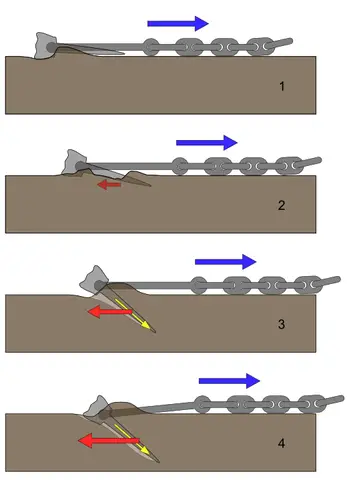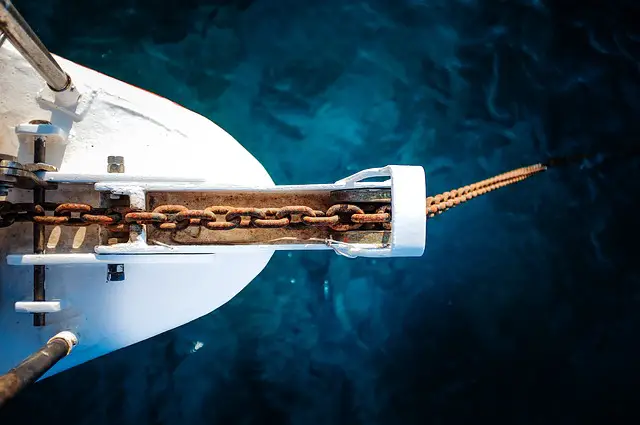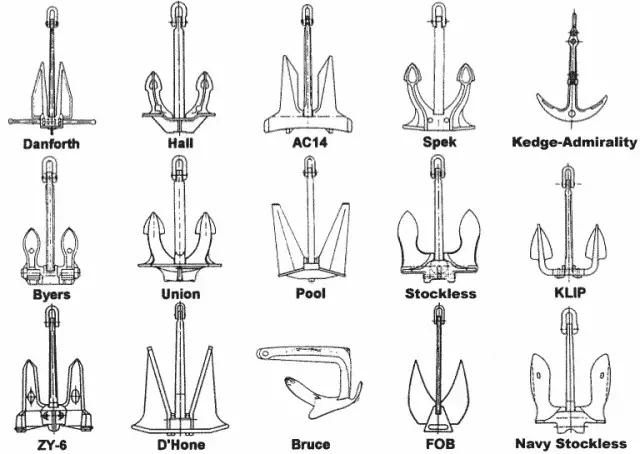In this article, you will not only learn all the basics about anchors. You even get all the more advanced knowledge you need about how anchors work. Use the table of content if you search for an answer on a specific topic.
How Does An Anchor Hold A Ship?

The primary force holding an anchored ship in place is the weight of the chain on the bottom of the sea.
The wind will push the boat away from the anchor and keep the chain in place.
Most anchors have flukes designed to dig into the ground. If the anchor is in the correct position, it will dig in deeper when wind or waves put pressure on the chain.
As you can see in the drawing, the anchor digs deeper into the seabed if the chain is pulled horizontally away from it.
To retrieve the anchor, the lift must be made vertically. This will happen when you pull in the chain, and the boat is directly above the anchor.
How Deep Do Ship Anchors Go?
Does A Boat Anchor Have To Touch The Bottom?
Yes, all anchors rest on the seabed. An anchor is designed in such a way that it digs into the seabed and holds the boat from moving away. An anchor works together with a chain.
One exception is a drogue which I will get back to later.
How Much Chain Do You Need?
As a rule of thumb, you need a chain in the amount of 5 to 7 times the depth of the water.
How much anchor line should you use if the water is 20 feet deep?
With the above-mentioned rule, you would need at least 100 feet of chain.
How Deep Do Sea Anchors Go?
As stated above, how deep an anchor goes depends on the depth of the sea combined with the length of the chain. This is why it is not possible to anchor in deep seas, you simply cannot carry that much chain.
Coasters, ferries, and other large commercial ships like dry bulkers and tankers often anchor longer from the cost than leisure boats or even at special anchor areas defined by port authorities. They have a bigger draft (deeper keel) and need a lot of space to maneuver in.
How Does A Ship Anchor Work In Deep Water?
In deep water, as I have already said, it requires a substantial amount of chain to touch the bottom. That’s why instead of an anchor, they use a large and strong underwater “parachute” also known as a storm drogue that provides a drag, which acts as a brake.
As this sea parachute is made out of fabric, it can be stored away easily. A drogue will not hold the ship in place but slow you down significantly.
In emergencies, you could use almost anything as a drogue. A plastic bag, the bag from a sail or similar.
Types of Anchors
There are generally spoken three types of modern anchor designs. The fluke anchor, the plow anchor, and the claw anchor. They all work by digging into the seabed.
Older anchor types “grabs on” rather than dig in, making them less effective than the modern models.
Both the fluke, the plow, and the claw anchor are designed with a top and a bottom. The bottom is heavier than the top, which means that it almost always turns correctly when it lands on the seabed.
Fluke Anchor
Fluke anchors are very popular on small boats and with good reason.
- It is Lightweight
- It stoves away very easily (folds up and takes only a little storage room)
- It holds well in mud or sand
On the negative side, the fluke anchor doesn’t hold very well on grassy or rocky surfaces.
Plow Anchor
Plow anchors are a safer choice if you need an all-around anchor for your boat.
Plow anchors have fixed shanks and look like a plow.
- It reset itself if the wind or current changes direction
- Holds effectively in grass, mud, and sand
On the negative side is the higher weight and need for a storage room.
Claw Anchor
A claw anchor is the cheapest type of modern anchor due to its simple design. It holds okay in any seabed but is a bit harder to handle, in my opinion. Its design is adapted from anchors used to secure oil rigs in the North Sea.
Like the plow anchor, it does not fold away and takes up a lot of storage room.
Anchor types are often named after the manufacturer who invented it, but you will find many copies with another brand name. A good example is the Bruce anchor (the claw anchor), which is a brand but also often referred to as a particular type of anchor. Bruce does not produce this type of anchor anymore, but you will find others who do.
The Weight Of The Anchor
The weight of the anchor depends on how heavy your ship is. But most important is to look at the anchor manufacturer’s suggested size.
And remember that anchor weight cannot stand alone, you also need a chain to hold the anchor. This chain acts as a shock absorber.
It is found that for small boats, one pound of anchors for every foot of boat length, is a general rule of thumb.
Suppose you have a 25’ boat, so you need a 20-25lb Bruce anchor with 50’ of 1/4 chain and 500 feet of chain to anchor in 100’ of water comfortably.
Why Do Some Ships Have 2 Anchors?
There is more than one reason why a ship would carry two anchors:
- Different anchors are needed for different seabeds
- Staying put instead of moving in circles
- For various safety reasons
Most of the time one anchor is enough to keep the ship in place but sometimes ships need to set 2 anchors to keep them in place.
Some ships carry an extra anchor because anchors can be easily lost due to various reasons like heavy wind, bad weather, strong current, etc.
Most ships have 2 anchors because with only one anchor you can move in a circle and with another, you are positioned in one place.
What Happens If An Anchor Gets Stuck?
Anchors are sometimes left behind because they get stuck, and anchors do get stuck from time to time, especially if you are not using a windlass. If this happens, the anchor will lay on the bottom of the sea until rusted and sanded into small particles of metal.
Many sailors have experienced lifting their anchor and accidentally retrieving an old anchor too.
Why Do Ships Lose Their Anchors?
Here are some of the most common reasons why ships sometimes lose their anchor:
- Inadequate securing
- Equipment failures
- Broken anchor line
- Abandoned anchor
- Environmental risk factors
Inadequate Securing
Not operating the anchor gear sufficiently is a common reason for losing the anchor. Especially not securing the end of the line or chain while focusing on other maneuvers happens very often.
Having a suitable and rehearsed procedure will prevent this from happening in most cases.
Equipment Failures

The anchor chain gets rusty, and lines lose their strength with age. It is essential to maintain all gear on a boat and to review all equipment regularly.
Rusty Anchor Line
Anchor lines are exposed if someone sails across them, and get the line in their prop. The prop can get damaged, but also the anchor line is likely to brake.
That is why it is crucial to stay clear of anchored vessels.
Many ships today do not use anchor lines and have only anchor chains, making anchoring more safe.
Abandoned Anchor
Ships sometimes have to leave the anchor behind, if the anchor is stuck – This happens only rarely with the modern types of anchors.
Environmental Factors
Environmental factors such as weather, the strength of the currents, and water depth are some of the most common reasons for losing anchors.

